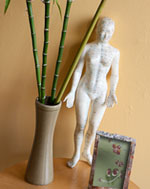Acu-FAQ
Does Acupuncture Hurt?
Most people describe the sensation at the needles to be one of warmth, energy, pulsation, pressure, or tugging, followed by relaxation and an increase in circulation to the area. The needles used for acupuncture treatments bear little resemblance to the needles used to give shots. They are hair-thin, flexible, and can be precisely manipulated by a skilled practitioner to achieve the desired results. My needling technique is very gentle, tailored to be as painless as possible for even the most sensitive client.
How does Acupuncture work?
Acupuncture stimulates circulation and blood flow in pathways known as meridians. When treating aches, pains, inflammation, and stiffness, the practitioner may either place needles directly into the affected area, locally stimulating blood flow, or into distal points along these meridians. Muscles relax, pain and inflammation are decreased, and circulation is improved, which helps the injured area to recover and heal.
Though it is most famous for its role in pain management, acupuncture has many other benefits. It can decrease feelings of stress, boost energy levels, improve digestion, enhance fertility, and balance moods, leading to an improved quality of life.
Is Acupuncture Safe?
Acupuncture is extremely safe. All needles are sterile, disposable, and individually packaged. We use isopropyl alcohol to clean the skin before needles are inserted. Needles are disposed of in a sharps container at the end of the treatment.
What Conditions does Acupuncture Treat?
- Chronic Pain/Stiffness: Arthritis, Bursitis, Tendonitis, Carpal Tunnel Syndrome, Fibromyalgia, Tennis Elbow, Knee Pain, Low Back Pain, Heel Pain, Ankle Pain, Shoulder Pain/Frozen Shoulder, Neck Pain, Hip Pain, Sciatica, Calf Cramps, Repetitive Strain Injuries
- Headaches & Migraines
- TMJ
- Post-surgical Pain
- Trauma pain from acute injuries, including post-concussion syndrome
- Women’s Health: PMS, Menstrual Cramps, Irregular Menstruation, PCOS, Uterine Fibroids, Endometriosis, Perimenopause, Post-menopause, Infertility, Pregnancy Support, Labor Induction, Low Milk Production
- Sleep problems
- Chronic Fatigue Syndrome
- Anxiety & Depression
- Stress
- Asthma
- Allergies & Sinusitis
- Digestive Issues: Nausea, Vomiting, Acid Reflux, Constipation, Diarrhea, IBS, Ulcerative Colitis, Peptic Ulcers, Gastritis
- Quit Smoking
- Skin Issues: Eczema, Psoriasis, Acne
- Bell’s Palsy
- Eye pain & twitching
- Ear pain
- Stroke Rehabilitation
- Complementary care in cancer treatment to improve well-being and ameliorate side effects of chemotherapy & radiation
What is Ear Acupuncture?
Ear acupuncture, also known as auriculotherapy, is another method of treating pain and other conditions through distal points. Every area on the body maps out to a very precise spot on the ear. Auriculotherapy is especially useful in helping people quit smoking, lose weight, and recover from addictions, using a combination of 5 auricular points known as the NADA protocol. Auriculotherapy was developed and popularized in France in the 1950′s, but it is now used worldwide.
What is Electroacupuncture?
Some types of muscle and joint injury respond more quickly to acupuncture when a fine electrical current is applied to the needles using a special stimulation unit. It is also useful for stroke rehabilitation.
How Should I Prepare For My Treatment?
Come as you are! Wearing comfortable, loose-fitting clothes is helpful. It’s best not to come on a totally empty stomach, as you may feel dizzy afterwards. If it’s cold outside, make sure you are able to bundle up after the treatment so that your body can stay relaxed.
How Many Visits Will I Need?
Mild or newly present symptoms usually feel much better after just one or two treatments. Longer-term, more chronic conditions may take a series of 5 to 10 treatments to see lasting results. Fertility enhancement is a longer-term process which may take several months/cycles of treatment. Generally speaking, conditions which took a longer time to develop will take longer to treat.




Connect: